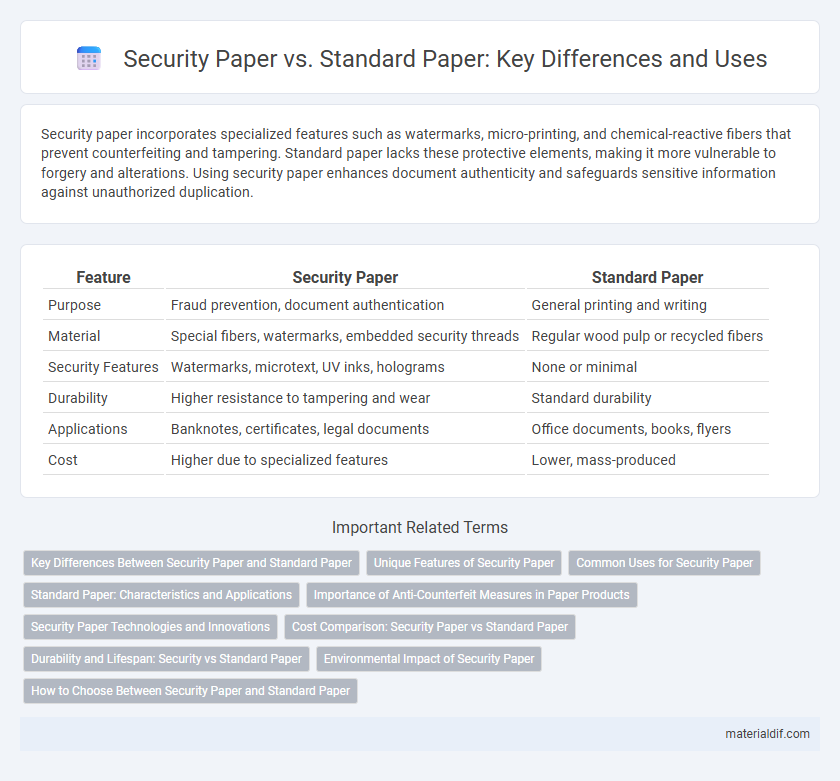Security paper incorporates specialized features such as watermarks, micro-printing, and chemical-reactive fibers that prevent counterfeiting and tampering. Standard paper lacks these protective elements, making it more vulnerable to forgery and alterations. Using security paper enhances document authenticity and safeguards sensitive information against unauthorized duplication.
Table of Comparison
| Feature | Security Paper | Standard Paper |
|---|---|---|
| Purpose | Fraud prevention, document authentication | General printing and writing |
| Material | Special fibers, watermarks, embedded security threads | Regular wood pulp or recycled fibers |
| Security Features | Watermarks, microtext, UV inks, holograms | None or minimal |
| Durability | Higher resistance to tampering and wear | Standard durability |
| Applications | Banknotes, certificates, legal documents | Office documents, books, flyers |
| Cost | Higher due to specialized features | Lower, mass-produced |
Key Differences Between Security Paper and Standard Paper
Security paper incorporates advanced features such as watermarks, microprinting, and chemical sensitivity to prevent tampering and forgery, whereas standard paper lacks these protective elements. The durability of security paper is enhanced to withstand attempts at alteration or duplication, while standard paper is primarily designed for everyday printing without anti-fraud measures. Security paper is commonly used for documents requiring high authenticity, including certificates and legal papers, contrasting with the general-purpose use of standard paper.
Unique Features of Security Paper
Security paper incorporates specialized features such as watermarks, microtext, and embedded fibers that prevent counterfeiting and unauthorized copying. Unlike standard paper, it often includes chemical coatings to detect alterations and tampering, enhancing document integrity. These unique attributes make security paper ideal for sensitive documents like certificates, banknotes, and legal contracts.
Common Uses for Security Paper
Security paper is specifically designed for important documents such as certificates, legal papers, and prescription pads, where fraud prevention is critical. This type of paper incorporates features like watermarks, embedded fibers, and chemical sensitivity to deter tampering and counterfeiting. Standard paper lacks these protective elements and is typically used for everyday printing and copying tasks.
Standard Paper: Characteristics and Applications
Standard paper is typically made from wood pulp with a brightness level of 80-90%, providing a smooth surface ideal for everyday printing and writing tasks. It offers moderate durability and is cost-effective, making it suitable for office documents, books, and promotional materials. Standard paper lacks security features like watermarks or embedded fibers, rendering it insufficient for sensitive or official documents requiring authentication.
Importance of Anti-Counterfeit Measures in Paper Products
Security paper incorporates advanced anti-counterfeit features such as watermarks, security threads, and microprinting to prevent forgery and ensure authenticity. Standard paper lacks these specialized elements, making it vulnerable to duplication and fraud. Implementing anti-counterfeit measures in paper products is crucial for protecting sensitive documents like currency, certificates, and official records from counterfeiting and unauthorized reproduction.
Security Paper Technologies and Innovations
Security paper incorporates advanced technologies such as embedded watermarks, UV-reactive fibers, and microprinting to prevent counterfeiting and unauthorized reproduction, distinguishing it from standard paper. Innovations like thermochromic inks, holograms, and RFID chips further enhance the protection of sensitive documents including banknotes, certificates, and legal papers. These cutting-edge features create multiple layers of security, making security paper essential for safeguarding identity, authenticity, and fraud prevention.
Cost Comparison: Security Paper vs Standard Paper
Security paper typically incurs higher production costs due to embedded features such as watermarks, microprinting, and anti-copy patterns, which enhance document protection. Standard paper is more economical as it lacks these specialized security elements, resulting in lower manufacturing expenses and retail prices. When choosing between the two, organizations must weigh the increased cost of security paper against the potential risks and losses associated with document fraud and counterfeiting.
Durability and Lifespan: Security vs Standard Paper
Security paper features embedded fibers, watermarks, and chemical coatings that significantly enhance its durability and lifespan compared to standard paper. Standard paper typically lacks these protective elements, making it more susceptible to wear, fading, and tampering over time. The advanced composition of security paper ensures prolonged resistance to physical damage and environmental factors, preserving document integrity for extended periods.
Environmental Impact of Security Paper
Security paper is engineered with embedded features like watermarks and chemical coatings to prevent counterfeiting, which often requires the use of specialized fibers and additives that can increase environmental footprint during production. Standard paper, typically made from bleached wood pulp, generally involves less complex processing, resulting in lower energy consumption and reduced chemical waste. The environmental impact of security paper can be mitigated through sustainable sourcing of raw materials and adoption of eco-friendly manufacturing practices such as chlorine-free bleaching and recycling of production waste.
How to Choose Between Security Paper and Standard Paper
Choosing between security paper and standard paper depends on the level of document protection required; security paper integrates features like watermarks, microprinting, and tamper-evident patterns to prevent forgery and unauthorized copying. Standard paper suits everyday printing needs without specialized anti-counterfeiting measures, making it more cost-effective for general use. Evaluating the sensitivity of the information and the risk of fraud guides the selection between these two paper types.
Security paper vs Standard paper Infographic

 materialdif.com
materialdif.com